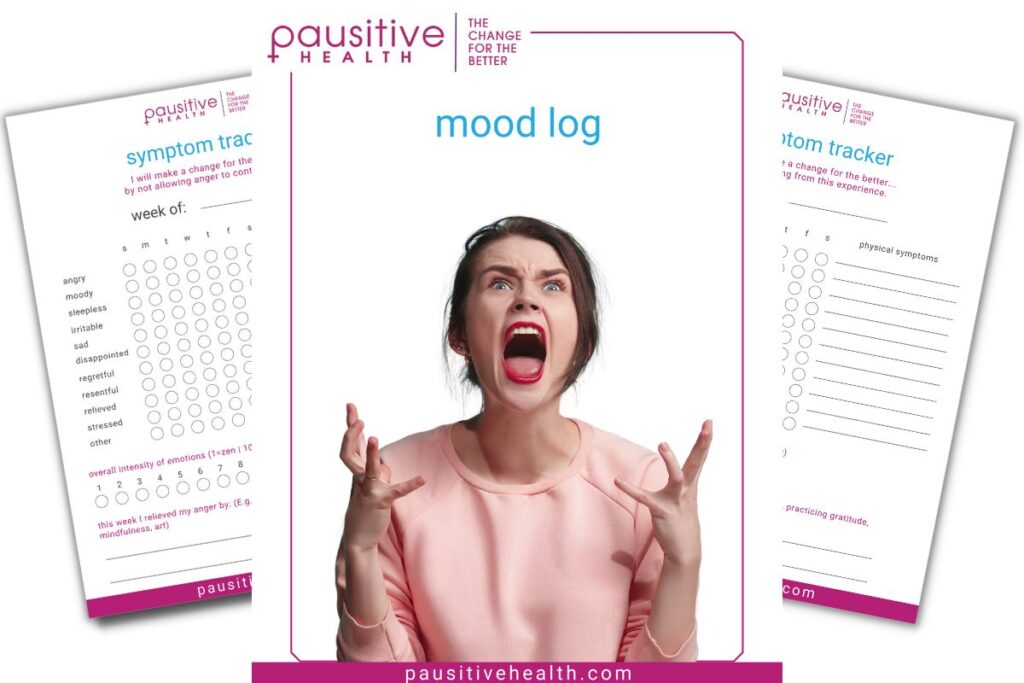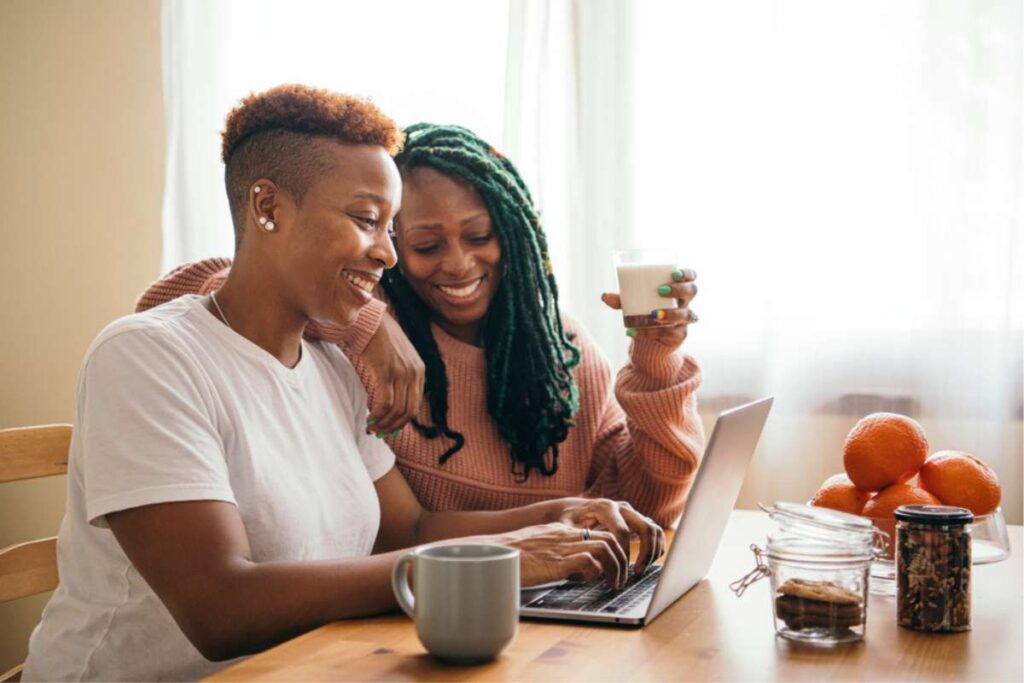While individuals in the LGBTQIA+ community tend to have a more positive view on menopause, it doesn’t mean it’s not without its challenges. There are unique challenges that can lead to personal and relationship stress. Try these 7 ways to strengthen LGBTQIA+ relationships so you can find greater happiness during menopause.
LGBTQIA+ relationships during menopause
Studies indicate the mindset of LGBTQIA women+ is generally more positive than that of cisgender, heterosexual women on the menopause journey.
That same generalization can also carry through to your relationship with your partner(s) during menopause, compared to women married to a man.
That being said, we recognize that every journey is unique.
Even the most positive outlook isn’t a surefire buffer for relationship stress. We’re all human, and when change happens, it’s common to experience anger or even rage.
New, more volatile, or stronger feelings due to dips in estrogen can leave you feeling more, or more frequently, frustrated than usual. Whether it’s night sweats keeping you awake and exhausted or brain fog, you may be less attentive to your relationship.
Feelings of stress, sadness, and even mood disorders such as depression and anxiety are also common during the menopause transition.
Even if you’ve usually had a calm or sunny disposition, you may find yourself snapping at your partner/spouse or disinterested in the date nights you used to enjoy. No matter how much we love someone, it’s easy to take stable relationships for granted.
If anger or other emotions are getting the best of you and your relationships, focus on what causes you to feel angry and ways to manage it.
And find ways to channel your anger into a positive force.
“Double menopause”
For LGBTQIA+ women in lesbian partnerships, these frustrations can be amplified when both partners enter the menopause transition around the same time. Referred to as “double menopause,” miscommunication can abound when both women are dealing with symptoms such as mood swings, irritability, and sleeplessness.
For transgender men with reproductive anatomy still intact that produces estrogen, gender dysphoria (psychological distress that results from an incongruence between one’s sex assigned at birth and one’s gender identity) may arise during menopause depending on their hormonal regimen (or lack thereof) and stage of transition. Having a period and shifts in estrogen that lead to symptoms like hot flashes can be a reminder of the sex with which they were born but with which they no longer identify.
Some transgender women experience symptoms similar to those in the menopause journey, like hot flashes and night sweats. This would occur if they choose to lower or discontinue hormone therapy as they age to reduce the potential risks of long-term estrogen use (e.g., heart disease, stroke, blood clots, and breast cancer). It can also happen if it is stopped for a short while prior to certain surgical procedures, for which there is a higher risk of development of blood clots.
If you’re struggling personally, your relationships may struggle too, and vice versa.
Women+ can use these shifts and these relationship techniques to improve their mindset and strengthen their connection with their partner/spouse.
- Speak up. Be candid with each other.
- Manage emotions.
- Get the care you need.
- Embrace change as a positive.
- Celebrate your unique story.
- Find strength in your community.
- Spend intentional time together.

How to strengthen your relationship during the menopause journey
Despite all the potential challenges, this doesn’t have to be a time to give up on your partner. Not only can you weather the difficulties together, there are so many ways to make the menopause journey an opportunity to strengthen your relationship — and rekindle or intensify your romance. And, especially if your partner is in menopausal transition too, they’ll likely be more understanding and patient than you think. But it all starts with communication.
1. Speak up and be candid with your partner/spouse
No matter how well your partner knows you, no one is a mind reader. First and foremost, make sure they know you’re on the menopause journey, especially if you’re one of the 6% of women who go through premature or early menopause. No matter when the journey starts, and even if it seems obvious you’re on the journey, your partner may not be aware of the transition you’ve begun.
Start by being open about your feelings in a calm, distraction-free environment. Instead of bringing up concerns in the heat of the moment, wait until you are both comfortable and focused. Going somewhere private, without work and other stressors, can also help you assess the situation more clearly.
Let them know how the transition has been affecting you mentally and physically. Be honest about situations that tend to trigger your symptoms. Are you taking any extra measures for self-care?
Even though you might be frustrated, take blame out of the equation whenever possible.
A tried and true method?
“I” statements: “I feel [blank] when [insert stressor].” This helps your partner empathize with your point of view without feeling under attack and getting defensive.
As you express yourself, don’t forget to listen to their emotions, too. You may gain vital insights about their experience. Maybe it seems like their interest in sex with you has waned, but they’re also struggling with body image, age-related changes, or something completely unrelated to your relationship. They may even have a completely different perspective than what you thought.
For lesbian couples experiencing “double menopause,” shared emotions can be a significant source of connection. When both partners are navigating the same type of life changes at the same time, you can commiserate over the frustrations and share the humor and even joy that is possible during the transition.
If vulnerable conversations are difficult for you, another option is to write a letter. By getting the words on paper, you can think through exactly what you have to say without getting shy or flustered in the moment.
Above all, remember there’s nothing to be ashamed of. Menopause is a natural, inevitable stage of life, and there are many options to help address both the physical and emotional symptoms you’re experiencing.
2. Manage emotions on your own or with therapy.
Sometimes, despite our best intentions, we’re not our kindest or most forgiving selves. While it’s okay to try to make it through tough times and low moods on our own, we may need extra help regulating the new feelings menopause brings.
There are many paths to help manage your emotions, including tracking your triggers with an anger log.

Get Relief From Your Emotions
Having mood swings? Track how you feel, identify your triggers, and find ways to calm the emotional firestorm with this mood log.
"*" indicates required fields
You can also try:
- journaling
- mindfulness meditation
- exercise
- music
- noticing and reframing your negative thoughts using cognitive behavioral therapy (CBT)
- therapy
If you do choose to attend therapy, either by yourself or as a couple, it’s important to advocate for yourself as you would in the doctor’s office. A therapist should avoid making assumptions, instead creating an open, non-judgmental, safe space for your feelings and experiences.
3. Decide to embrace change as a positive.
Change is not only inevitable, but it’s part of life’s magic. As women+ age, they can grow in beauty, wisdom and strength—not to mention potentially reach new career achievements.
In some cultures, getting older brings greater status and freedom. Not only should aging be normalized, but be celebrated as well. By changing the narrative, women can be acknowledged as the powerful role models, community leaders, and wonderful people they are.
Having a positive mindset about menopause is even linked to symptom severity. For example, one study found that women with a more positive attitude tended to have a more positive body image and less depression.
These concepts apply to relationships as well. By menopause, many people have had 20, 30, or even 40 years with their partner. Your shared history can be a profound source of love and intimacy.
While it’s important to reflect on the beautiful times you’ve had in the past, think of the new adventures you can have together in the future, too.
For example, maybe you’re finally in a role at work that has more flexibility. These openings can be the perfect opportunity for the bucket list trip you’ve always wanted to take or even small, new traditions like cooking together once a week.
4. Get the care you need.
You can’t pour from an empty cup, and during the menopause journey, this maxim is as true as ever. Yet, it can be difficult to accomplish when you consider some of the hurdles to getting the care you need.
Many LGBTQIA+ women experience additional difficulties finding care, especially from practitioners who have the expertise, experience, and comfort level to address the needs of both menopause and same-sex couples. This care challenge is even more pronounced for transgender individuals.
Perhaps because of these “blind spots” in research and expertise, lesbian women experience higher rates of certain cancers, e.g., for breast, cervical, and ovarian, compared to cisgender, heterosexual women.
And then there are conditions like hypertension, diabetes, and depression. The risk increases because of the hormonal changes that occur during the journey, and for which there are greater rates in LGBTQIA+ people.
Remember, these are generalizations—and they’re thought to be partly caused by less frequent use of healthcare services in the LGBTQIA+ community due to fear of or experiences of provider insensitivity and lack of expertise. 24% of trans individuals, for example, report avoiding doctor’s visits altogether.
But you can still get the high-quality healthcare you deserve. One place to start is self-advocacy.
Educate yourself about options, hormonal and non-hormonal, and be clear about your needs and concerns during healthcare visits.
You can also explore the following resources to find LGBTQIA+ trained providers in your area:
- Outcare: Find an LGBTQ+ Affirming Provider
- Health Professionals Advancing LGBTQ+ Equality: GLMA Healthcare Directory
- CDC: LGBTQ+ Health Clinics by State and City
- World Professional Association for Transgender Health (WPATH): Provider Directory
- Human Rights Campaign (HRC) provides the Healthcare Equality Index to evaluate how well healthcare facilities deliver LGBTQ+ inclusion.
Another option is to ask friends in your community for recommendations.
And if a provider isn’t giving you adequate care? Try to find another doctor. The Menopause Society (previously the North American Menopause Society or NAMS) has a directory of practitioners with specific training in managing the menopause journey.

5. Celebrate your unique story with your partner.
Throughout history, LGBTQIA+ individuals have been known for their power to create their own narratives. In a society built on cis gender, heterosexual paradigms of love and family, same-sex couples have forged their own paths and definitions.
….we must dream and enact new and better pleasures, other ways of being in the world, and ultimately new worlds.
~ José Esteban Muñoz, Cruising Utopia: The Then and There of Queer Futurity
You can apply this same power to menopause.
Jose Esteban Muñoz—renowned queer scholar—describes a vision of aging that’s not dependent on health, wealth, and heterosexuality. Counter-narratives, or stories that oppose a more dominant way of organizing the world, can enhance ownership of what you want from your present and future. The menopause journey in particular, with all its natural changes, can be an incredible time to take pride in your journey with your partner.
Reflect on these questions:
- What values do you want to uphold most?
- What experiences do you want to prioritize?
Imagining your path with your partner can help reignite your shared zest—and sense of agency—through menopause and beyond.
6. Find strength in your community.
The LGBTQIA+ community can be a source of strength and support. For example, counter-normative spaces and resources, including activist newsletters and events, can offer valuable resources for inclusive aging.
Participating in the community with your partner can also provide a sense of shared purpose. You could even get involved in the efforts to improve care at the intersection of menopause and LGBTQIA+ health and well-being. Plus, having a network of friends takes the pressure off your partner to meet all your needs.

7. Spend intentional time together.
In theory, we may wish we spent more time with our partner/spouse. But during menopause, it can seem as though life keeps getting in the way.
Nonetheless, whether you’re feeling apathetic towards everyday activities or overwhelmed by the “care sandwich” (caring for both children and aging parents), chances are there’s still room for dates if you look for opportunities with intentionality. Even simple activities like short walks, coffees, or a cozy night in can go a long way in strengthening your bond with your partner.
You can even take up new hobbies together, especially ones that promote well-being. Fencing or boxing, anyone?
Studies show that proximity is strongly correlated with love. Essentially, the more time you spend with your partner, the more affection can grow. Find times that work for both of your schedules and pen them into your calendars. The act of planning can help you look forward to it and make it more likely to actually happen.
No phubbing! Be sure to limit technology when you’re together as well. Whenever possible, stay off emails and focus on your partner. You might have thought you knew almost everything about them, but just as you’ve been experiencing shifts, chances are they have some new insights to share with you too.
Power of a strong relationship
When you feel good about your relationship, you’ll likely feel better about yourself, have a more positive mindset, and potentially a menopause journey with less severe symptoms. Taking time to make a change for the better is an investment in strengthening your relationship as well as your health and well-being.
LGBTQ+ & Menopause | Menopause Experts
How To Use A Gratitude Journal To Boost Your Happiness | PeopleTweaker
Cognitive Behaviour Therapy (CBT) for Menopausal Symptoms | Women’s Health Concern
Cancer Facts for Lesbian and Bisexual Women | American Cancer Society
You may also like…

Empowering LGBTQIA+ Health: Cancer Knowledge Is Power. Learn The Risks
We’re empowering LGBTQIA+ health with information on LGBTQIA+ cancer risks. There’s no better time to invest in your health than menopause.

Transgender Menopause: What to Expect
Transgender menopause can happen. Learn what to expect.

Menopause Pride: The LGBTQIA+ Experience And Where to Find Inclusive Doctors
Every menopause journey is unique. For LGBTQIA+ people there are positives and challenges, like health disparities. Learn how to have menopause pride by knowing what to expect.

